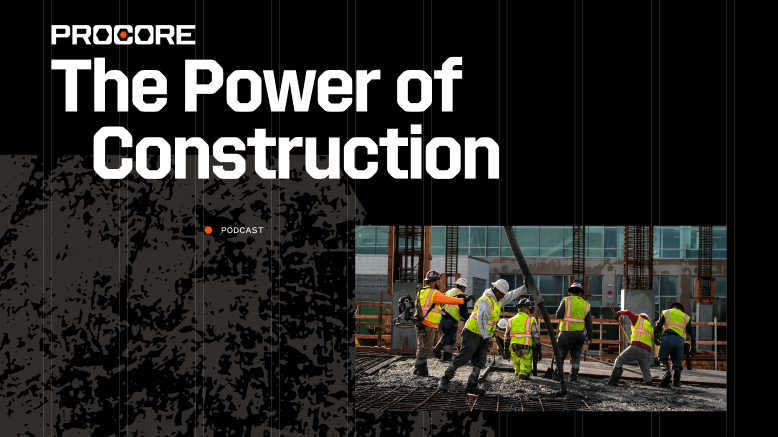— 9 min read
Vet Contractors with Confidence: A Guide to Smart Bidder Selection
Last Updated Aug 8, 2025
Israel Simmons
Civil & Infrastructure Solutions Specialist
11 articles
Israel Simmons, DBIA, CCM, PMP is a seasoned construction professional with over 12 years of leadership experience delivering over $3 billion in complex civil and infrastructure projects across the U.S. His diverse portfolio spans major freeways, bridges, rail, wastewater treatment plants, aviation, and more. He joined Procore to help transform the construction industry through a unified, integrated platform that streamlines project execution from start to finish. Israel earned a bachelor’s degree in construction management with minors in Business Administration and Communications from Drexel University.
Taylor Riso
Contributing Writer
91 articles
Taylor Riso is a marketing professional with more than 10 years of experience in the construction industry. Skilled in content development and marketing strategies, she leverages her diverse experience to help professionals in the built environment. She currently resides in Portland, Oregon.
Last Updated Aug 8, 2025

Selecting the right bidder is one of the most consequential decisions a construction team makes — yet it often happens under tight deadlines, with limited visibility into the long-term implications. While lowest-cost selection remains a standard practice across much of the industry, particularly in public and hard-bid environments, it rarely guarantees the best outcome.
Leading contractors are shifting toward a more holistic approach that weighs qualifications, past performance, communication and value — factors that ultimately determine whether a subcontractor can deliver what’s promised when it’s needed at the expected standard of quality.
This article explores what makes bidder selection so complex, where traditional processes fall short and how to create a system that consistently results in better outcomes for all project stakeholders.
Table of contents
What Makes Bidder Selection Difficult
Even under the best circumstances, selecting the right bidder requires more than comparing prices.
When a bidder is chosen without careful vetting, the risks can compound quickly. Missed deadlines, unexpected change orders, workforce disruptions and strained client relationships are just a few of the issues that can arise when the selected subcontractor isn’t the right fit for the job.
These challenges aren’t always the result of obvious red flags. In many cases, teams are limited by geographic constraints, regulatory requirements or a lack of qualified bidders for a specialized scope. Other times, they may default to a low number without understanding how the bidder got to that price — or what was left out.
Historical performance is another common gap. A contractor may hold the correct license and demonstrate a solid track record, but if there's no prior working relationship — or worse, a negative one — the risk grows significantly.
These challenges can be even more common on public jobs, where small business or disadvantaged business enterprise (SBE/DBE) requirements can make it challenging to prioritize capability over eligibility.
Public procurement rules can further complicate the process. While there's a growing trend toward qualifications-based or best-value selection, many projects are still awarded on a low-bid basis, leaving little room to account for experience, reliability or known performance issues.
Then there’s the gray area of pricing ethics. Practices like bid shopping—where one bidder’s number is used to pressure another—may not always be illegal, but they raise questions around fairness and trust. Some bidders may also submit unrealistically low numbers, knowing they can pursue change orders later by exploiting scope gaps or technical ambiguities.
These dynamics make bidder selection as much about risk mitigation as it is about cost. Without a deliberate approach, teams can find themselves locked into contracts that compromise both the project and the relationships behind it.
Common Risks in Bidder Selection
Even with the best intentions, teams can end up selecting bidders that introduce more risk than value. Whether it's pricing that’s too good to be true or scope assumptions that don’t hold up under scrutiny, poor bidder selection can undermine the project before work even begins.
1. Non-responsible Bids
A bid that comes in far lower than the rest may look appealing on paper — but it often signals trouble ahead. Some contractors submit unrealistically low bids knowing they can pursue change orders later, once the job is underway.
Others may simply miss key scope items or underestimate risk. In either case, it sets the stage for cost overruns, schedule slips and strained relationships.
2. Scope Exploitation
Ambiguities or errors in the bid documents can create openings for bad actors. Instead of flagging issues during the bidding process, some contractors intentionally stay silent, submit a low number, then use RFIs or change orders later to drive the price back up. This kind of strategy not only erodes trust but can create major coordination challenges downstream.
3. Prioritizing Eligibility over cCapability
On projects with SBE/DBE participation goals, teams may focus on checking the right boxes without fully assessing whether the contractor is equipped to perform.
When a firm lacks the resources or experience to execute their scope, it can lead to payment issues, labor disruptions and rework — often at a cost to other parts of the job.
Meeting participation goals for small and historically marginalized businesses is important — but if you don’t take the time to understand whether a firm is truly ready to perform, you risk setting them up to fail. The key is finding ways to support these contractors so they can deliver, not just qualify.
Israel Simmons
Civil & Infrastructure Solutions Specialist
Procore Technologies
How the Traditional Process Falls Short
Too often, bidder selection begins and ends with a mass email. An Invitation to Bid (ITB) goes out, numbers come back and teams pick from the lowest three—without much dialogue, clarification or context. While this may check the box on paper, it leaves wide gaps in understanding that surface later as rework, disputes or change orders.
Without early engagement, bidders are left to make their own assumptions about scope, risk and logistics. Some may build in heavy contingencies to protect themselves. Others may underprice or miss key scope items entirely. Either way, the GC ends up with mismatched bid proposals — making bid leveling difficult and obscuring the true differences in scope and cost.
Just saying ‘Give me a quote on spec 23’ without any guidance is a recipe for ambiguity — and for disputes down the line.
Israel Simmons
Civil & Infrastructure Solutions Specialist
Procore Technologies
Compounding the issue is the lack of a consistent, documented process. Many teams don’t have a standard bid package or formal framework for bid evaluation beyond price. Qualifications, project history, safety performance and cultural fit often get overlooked, particularly under tight timelines.
The result? Even well-intentioned teams may end up awarding work to a bidder that was never set up to succeed. Fixing that starts with building more structure into the process—beginning well before the ITB goes out.
Best Practices for a Stronger Selection Process
A more reliable bidder selection process doesn’t just reduce risk — it sets the entire project up for success. Here are four practices that help teams move beyond low-bid selection and toward a model built on clarity, alignment and long-term value.
1. Prequalification
Before any scopes go out, establish a clear set of baseline requirements for bidders. This includes insurance coverage, bonding capacity, EMR ratings, project history, safety performance and references. Every firm has its own risk tolerance, so thresholds should reflect the project’s complexity and the level of oversight the team is equipped to manage.
2. Structured Scope Reviews
Pro Tip
How to Spot Scope Gaps Before They Become Change Orders: The most common gaps show up where scopes overlap — or where documents leave room for interpretation. Review spec sections, plans and bid documents with this in mind: What could be misunderstood, excluded or assumed by a bidder? In particular, be cautious with general notes, placeholder language (“as needed”) or vague references to coordination. Bring those areas up during scope review meetings and clarify them in writing for all bidders. The earlier ambiguity is caught, the fewer surprises will show up after award.
Specifications alone aren’t enough. Bidders need a detailed scope of work that clearly outlines expectations, responsibilities and inclusions. Pair that with one-on-one scope review meetings, where contractors can ask questions and flag concerns. These pre-bid meetings help align assumptions and reduce misinterpretations that could drive up costs later.
3. Transparent Risk Communication
Open communication leads to better pricing and stronger execution. Make space for bidders to ask questions — and make sure all clarifications are shared with every participant. That level playing field not only protects against disputes, it creates a more accurate picture of who’s truly ready to perform.
The more information you share early on, the better chance your preferred contractor has to reduce risk—and cost—up front.
4. Evaluating for Best Value
Not every award should go to the lowest number. On complex or specialized scopes, weigh qualifications, past performance and delivery capability alongside cost. For technical scopes or proprietary equipment, loop in designers or engineers to confirm that what’s being proposed meets both commercial and performance requirements.
When done right, bidder selection becomes a tool for risk mitigation, cost control and team alignment — not just a checkbox in procurement.
Build a Strong Foundation with our Preconstruction Course
With 20+ years of experience, Ben Ashburn teaches you how to streamline planning, bidding, and procurement for better outcomes.

Tools That Support Better Bidder Selection
A strong selection process depends not just on good judgment — but on the right tools to support clarity, consistency and communication. Without a centralized system, it’s easy for information to get lost across email threads, outdated file versions or misaligned expectations.
Centralized Bidding Platforms
Centralized bidding platforms help teams manage all bid-related activity in one place — bid packages, scope documents, RFIs and addenda. When every bidder works from the same information, it reduces the risk of miscommunication and creates a clear audit trail for tracking responses and resolving disputes. These tools also streamline coordination, making it easier to maintain transparency and consistency across the selection process.
Standardized Templates
Templates for scopes of work, evaluation criteria and qualification checklists can streamline procurement and create more consistent outcomes. They also reduce the likelihood of missing key details or relying on assumptions — particularly when multiple teams are involved in the selection process.
Controlled Document Access
Shared folders are easy to set up, but they’re often not built to handle the complexity of bidding when updates, clarifications and multiple participants need to be managed. Purpose-built platforms help assure every bidder sees the same documents, receives the same updates and has an easy way to submit questions or clarifications — without requiring teams to chase email chains or manually update files.
Investing in the right tools for bidder selection improves fairness, reduces risk and gives teams better visibility into how decisions are made.
Establishing a Stronger Selection Process
Strong bidder selection doesn’t happen by chance—it happens by design. Teams looking to improve their process should start by treating selection as a structured, repeatable workflow, not a one-off decision.
The first step is documenting that workflow. Define your goals, identify common risks and lay out a timeline that includes checkpoints for prequalification, scope review and evaluation. This creates clarity — not just for bidders, but for your internal teams as well.
Next, assign ownership. Make sure everyone involved knows their role in the process, from project managers and contract admins to owners and technical reviewers. Clear responsibilities reduce miscommunication and help keep the process consistent across scopes and project types.
Finally, treat each cycle as a learning opportunity. Build in time to review what worked, what didn’t and where scope gaps or bidder issues surfaced. Over time, those insights will lead to better outcomes—and a bidder selection process that’s built to scale.
Was this article helpful?
Thank you for your submission.
100%
0%
You voted that this article was . Was this a mistake? If so, change your vote
Scroll less, learn more about construction.
Subscribe to The Blueprint, Procore’s construction newsletter, to get content from industry experts delivered straight to your inbox.
By clicking this button, you agree to our Privacy Notice and Terms of Service.
Thank you!
You’re signed up to receive The Blueprint newsletter from Procore. You can unsubscribe at any time.
Categories:
Written by
Israel Simmons
Civil & Infrastructure Solutions Specialist | Procore Technologies
11 articles
Israel Simmons, DBIA, CCM, PMP is a seasoned construction professional with over 12 years of leadership experience delivering over $3 billion in complex civil and infrastructure projects across the U.S. His diverse portfolio spans major freeways, bridges, rail, wastewater treatment plants, aviation, and more. He joined Procore to help transform the construction industry through a unified, integrated platform that streamlines project execution from start to finish. Israel earned a bachelor’s degree in construction management with minors in Business Administration and Communications from Drexel University.
View profileTaylor Riso
Contributing Writer
91 articles
Taylor Riso is a marketing professional with more than 10 years of experience in the construction industry. Skilled in content development and marketing strategies, she leverages her diverse experience to help professionals in the built environment. She currently resides in Portland, Oregon.
View profileExplore more helpful resources

What Happens When Data Drives the Business?
Construction has long been seen as a low-margin industry. But what if the real problem isn’t the margins—it’s how decisions get made? In episode 17 of The Power of Construction,...

The Construction Bid Interview & Follow-up: Closing the Deal
During construction project bidding, the interview is often the last part of the request for proposal (RFP) process and one of the most influential. For teams that advance to the...
Construction Business Development: Tracking and Winning the Right Opportunities
Construction business development isn’t just a response to deadlines: It’s a long-term strategy rooted in focus, visibility and timing. Delays, funding gaps and market pressure have made it harder to...

Qualifications-Based Selection: Prioritizing Expertise over Initial Cost
For large or complex construction projects, owners and public agencies often use qualifications-based selection (QBS) to prioritize experience and capability over merely selecting the lowest bid. QBS involves owners choosing...
Free Tools
Calculators
Use our calculators to estimate the cost of construction materials for your next project.
Templates
Find a template to help you with your construction project tasks.
Material Price Tracker
Get the latest U.S. retail prices and view historical trends for common building materials.
Glossary
Explore key terms and phrases used in the industry.
